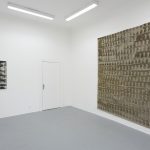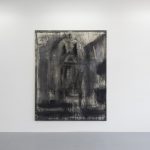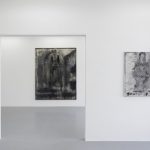JAKUB ŠPAŇHEL in Church /EXTENDED UNTIL MAY 16 – 2021
| Date | – |
|---|---|
| Vernissage | 07.01.2021 18:00 |
| Curator | Michal Škoda |
Author: Jan and Mikuláš Mahr
 In its first exhibition of the new year, the České Budějovice House of Art presents the work of Jakub Špaňhel.
In its first exhibition of the new year, the České Budějovice House of Art presents the work of Jakub Špaňhel.
Špaňhel is a painter through and through. One typical characteristic of his art is that he works in series that for the most part focus on one topic related to his view of everyday life. He calls his painting style “expressive impressionism” and likes to say that he always paints things that exist, because real objects strike him as so interesting and almost unreal that he basically doesn’t need anything else.
One important aspect of his work is that he “expresses” himself on two separate levels, though they are connected by certain shared characteristics – an inclination to the monochrome use of color and a reduction of form with a clear emphasis on painterly qualities. Špaňhel captivates the viewer with his characteristically expressive brushstrokes as well as with his specially constructed paint rollers, which he uses to give his paintings a highly minimalist, repetitive nature. We may thus encounter motifs of church interiors, candelabra, landscapes, central bank buildings, and gas stations, but also portraits, flowers, and butterflies. Or repeated images of pint glasses, crosses, boats, ballerinas, chimeras, and John of Nepomuk.
Jakub Špaňhel was born in 1976 in Karviná. He studied under Jiří David and Milan Knížák at the Academy of Fine Arts in Prague, but his art has also been influenced by Jiří Georg Dokoupil, with whom he once shared a studio in Prague. Outside of Prague, he has worked in Berlin, where he produced a series commemorating Bohuslav Reynek, and also at his studio in the Czech countryside. His works can be found in numerous public and private collections at home and abroad, and he has numerous exhibitions under his belt, both in the Czech Republic and throughout the world.
One of Špaňhel’s most recent exhibitions, dedicated to the story of John of Nepomuk, was held at Prague’s Arcimboldo Gallery in 2020. In this way, he came full circle from his work from the turn of the millennium, when he worked on this subject in a series of church interiors as part of his graduation work.
The aforementioned range of subjects may strike some as incompatible, but this incompatibility is merely an illusion, for Špaňhel’s work is firmly rooted in truthfulness and in his view of everyday life, which offers joyful moments as well as a contemplation of days that are less than perfect.
The common denominator of Špaňhel’s Baroque churches and central banks is wealth, money, gold. As he puts it: “I started with those churches. They possess the essence of that era, the best of architecture. Much of this was later transferred onto the secular world; today, money is in the banks.” We find a similar affinity with churches in Špaňhel’s series of candelabra, which – along with antique furniture – are a great collecting passion of his. The motif of butterflies is a reaction to a “simple” moment in the garden at his rural home. And his floral paintings grew out of the time he spent in his grandmother’s flower shop, where he was enchanted by flowers.
“Some people write a diary. I paint pictures. Sometimes, they are light things, sometimes heavy, but there are so many interesting things in the world! All it takes is to look around and walk with eyes open.” Špaňhel’s words can be taken as an invitation to go to church, which is the central theme of this remarkable painter’s first solo exhibition in southern Bohemia.
Wrote about the exhibition























